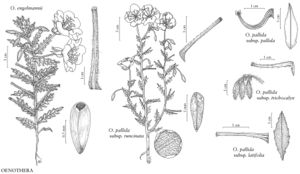Oenothera pallida subsp. trichocalyx
N. Amer. Fl., ser. 2, 5: 119. 1965.
Herbs usually annual, sometimes perennial, strigillose throughout and villous distally, especially on flower parts; from a taproot, when perennial sometimes lateral roots producing adventitious shoots. Stems single to several from base, usually unbranched. Leaves: basal rosette usually present at anthesis, 3–5(–7.8) × 0.4–0.8(–1.2) cm; blade narrowly lanceolate to oblong, margins pinnatifid or dentate. Flowers: buds with free tips 0–0.2 mm; floral tube 20–30 mm; sepals 10–18 mm; petals 10–20 mm. Capsules spreading to reflexed, straight or contorted. 2n = 14.
Phenology: Flowering (Apr–)May–Jun.
Habitat: Sandy, silty, or rocky soil in pinyon-juniper woodlands or shrublands, with Artemisia and Ericameria.
Elevation: 1100–2500 m.
Distribution
Ariz., Colo., N.Mex., Utah, Wyo.
Discussion
Subspecies trichocalyx occurs across central to southern Wyoming, eastern Utah, western Colorado, northeastern Arizona, and northwestern New Mexico. Within its range it has slight overlap with subspp. pallida and runcinata. In its purest form, subsp. trichocalyx is the most distinctive phase of Oenothera pallida, but many of the populations have characteristics that approach other subspecies with perennial habit (versus annual) appearing occasionally. Plants that are glabrous, or nearly so, like subsp. pallida, but with apparent short-duration habit and divided leaves like subsp. trichocalyx, occur in southern Wyoming and in the Uinta Basin region of Utah; only more typical plants of subsp. trichocalyx otherwise occur in the region without any current evidence of the presence of subsp. pallida.
Selected References
None.
